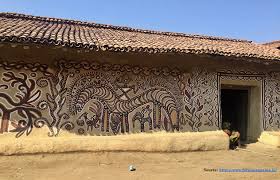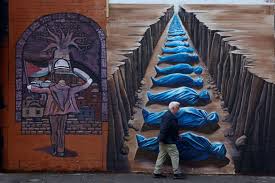
Menu

Barishal’s villages are more than green fields and winding rivers—they are living galleries where art blooms on humble walls. Rural wall painting and murals in Barishal represent a rich folk tradition where everyday spaces become vibrant expressions of culture, spirituality, and community identity.
Unlike grand urban murals or gallery art, these paintings are intimate, personal, and rooted in rural life. Village homes, often made of mud, bamboo, or lime-washed brick, provide ideal canvases. During festivals, weddings, or religious occasions, these walls come alive with hand-painted designs, making even the simplest homes radiant with meaning and beauty.
The motifs are typically drawn from nature and local symbolism. Stylized lotuses, creepers, peacocks, fish, and other flora and fauna celebrate Barishal’s lush environment. Geometric patterns, mandalas, and sacred symbols such as alpana designs (rice-paste patterns) often adorn doorways and courtyards, believed to bring luck and ward off evil. Hindu and Muslim households alike adapt these designs to their cultural contexts, showing a syncretic folk heritage.
One of the most charming aspects of rural wall painting is its communal, often matriarchal nature. Women traditionally lead the painting, teaching their daughters and neighbors the designs and techniques. These sessions are as much social gatherings as artistic endeavors—stories are exchanged, songs are sung, and traditions are passed on in living color.
The process is simple yet deeply meaningful. Natural pigments, lime wash, charcoal, and even rice paste create the base colors. Brushes may be handmade from local fibers or even fashioned from fingers. The simplicity of the materials contrasts with the intricate beauty of the finished work, reflecting the resourcefulness and creativity of rural artisans.
Beyond aesthetics, these murals serve cultural and spiritual functions. Decorating a home before a wedding symbolizes purification and blessing. During harvest festivals like Nabanna or religious observances like Eid or Durga Puja, the painted motifs mark gratitude, hope, and community pride. Even walls around schools or communal spaces may carry murals depicting folk tales, moral lessons, or environmental themes, serving as informal education for children.
Yet this tradition faces challenges. Migration, modernization, and the spread of concrete houses reduce the role of earthen walls and lime plaster that best hold these paintings. Younger generations may see the practice as old-fashioned or too time-consuming.
However, there is hope in renewed appreciation for folk art. NGOs, cultural programs, and tourism initiatives are documenting and encouraging rural wall painting. By valuing this living tradition, Barishal preserves not just art on walls but the stories, values, and spirit of its communities.
Barishal’s rural wall murals are not mere decoration—they are testaments to a people who find beauty, meaning, and shared identity in the very walls around them.



